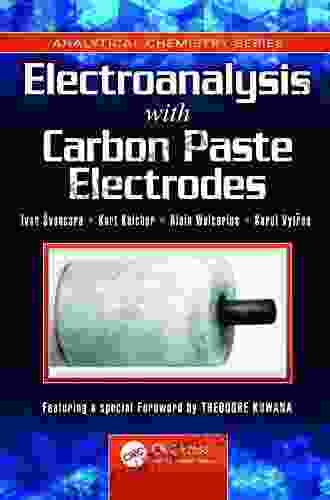Unlock the Power of Electroanalysis with Carbon Paste Electrodes: A Comprehensive Guide to Analytical Chemistry

Electroanalysis is a powerful analytical technique that utilizes electrochemical reactions to measure the concentration of analytes in a solution. Carbon paste electrodes (CPEs) are a type of working electrode commonly used in electroanalysis due to their unique properties and versatility. This article delves into the fascinating world of electroanalysis with carbon paste electrodes, providing a comprehensive overview of their analytical applications, principles, advantages, limitations, and recent advancements.
Carbon Paste Electrodes: An Overview
CPEs are composed of a mixture of carbon powder and a binder, typically paraffin oil or mineral oil. The carbon powder provides the electrical conductivity, while the binder holds the electrode together. CPEs offer several advantages over other types of working electrodes:
5 out of 5
| Language | : | English |
| File size | : | 92505 KB |
| Screen Reader | : | Supported |
| Print length | : | 666 pages |
- Renewable surface: The carbon paste can be easily renewed by simply polishing the electrode surface, removing any contamination or fouling.
- Wide potential window: CPEs exhibit a wide electrochemical potential window, allowing for the analysis of a wide range of analytes.
- Low background current: CPEs have a low background current, resulting in improved signal-to-noise ratios and increased sensitivity.
- Inertness: CPEs are chemically inert, making them suitable for analyzing a variety of solutions without the risk of electrode reactions.
Analytical Applications
CPEs are extensively used in various analytical applications, including:
- Environmental analysis: CPEs are employed to detect heavy metals, pesticides, and other pollutants in environmental samples.
- Biomedical analysis: CPEs are utilized in the analysis of biological samples, such as blood, urine, and tissue, for the detection of biomarkers and drug metabolites.
- Food analysis: CPEs are used to determine the presence of additives, preservatives, and other compounds in food products.
- Industrial analysis: CPEs are employed in the analysis of industrial processes, such as waste streams and product quality control.
Principles of Electroanalysis with CPEs
Electroanalysis with CPEs involves the following steps:
- Sample preparation: The sample is prepared by diluting or extracting the analyte of interest.
- Electrode preparation: A CPE is prepared by mixing carbon powder with a binder and forming a uniform paste.
- Electrochemical cell assembly: The CPE is inserted into an electrochemical cell along with a reference electrode and a counter electrode.
- Electrochemical measurement: The electrochemical response of the analyte is measured using techniques such as cyclic voltammetry, differential pulse voltammetry, or amperometry.
Advantages and Limitations
Advantages of CPEs:
- Low cost and easy to fabricate
- Renewable surface for improved reproducibility and reduced contamination
- Wide potential window for analyzing a variety of analytes
- Inertness towards most analytes
Limitations of CPEs:
- Limited stability over time, especially in aqueous solutions
- Susceptibility to fouling by organic compounds
- Lower sensitivity compared to other types of working electrodes
- Not suitable for analyzing highly concentrated solutions
Recent Advancements
Research efforts are continuously exploring ways to improve the performance of CPEs. Some recent advancements include:
- Modified CPEs: CPEs modified with nanomaterials, such as carbon nanotubes or graphene, have been developed to enhance their sensitivity and selectivity.
- Microfabricated CPEs: Microfabricated CPEs offer improved mass transport and reduced background current, leading to increased sensitivity.
- Screen-printed CPEs: Screen-printed CPEs are cost-effective and disposable, making them suitable for field applications.
- Coupling with other techniques: CPEs are being coupled with other analytical techniques, such as chromatography and spectroscopy, to provide comprehensive analytical solutions.
Electroanalysis with carbon paste electrodes offers a powerful and versatile approach to analytical chemistry. CPEs provide unique advantages, such as a renewable surface, wide potential window, and low background current, making them suitable for a wide range of analytical applications. The development of modified and advanced CPEs holds promise for even greater sensitivity, selectivity, and stability in electroanalysis. This comprehensive guide provides a valuable resource for researchers and practitioners interested in harnessing the power of carbon paste electrodes for their analytical needs.
Call to Action
Unlock the secrets of electroanalysis with carbon paste electrodes today! Free Download your copy of "Electroanalysis With Carbon Paste Electrodes Analytical Chemistry" now and elevate your analytical capabilities to new heights.
5 out of 5
| Language | : | English |
| File size | : | 92505 KB |
| Screen Reader | : | Supported |
| Print length | : | 666 pages |
Do you want to contribute by writing guest posts on this blog?
Please contact us and send us a resume of previous articles that you have written.
 Book
Book Novel
Novel Page
Page Chapter
Chapter Text
Text Story
Story Genre
Genre Reader
Reader Library
Library Paperback
Paperback E-book
E-book Magazine
Magazine Newspaper
Newspaper Paragraph
Paragraph Sentence
Sentence Bookmark
Bookmark Shelf
Shelf Glossary
Glossary Bibliography
Bibliography Foreword
Foreword Preface
Preface Synopsis
Synopsis Annotation
Annotation Footnote
Footnote Manuscript
Manuscript Scroll
Scroll Codex
Codex Tome
Tome Bestseller
Bestseller Classics
Classics Library card
Library card Narrative
Narrative Biography
Biography Autobiography
Autobiography Memoir
Memoir Reference
Reference Encyclopedia
Encyclopedia Dominic R Sondy
Dominic R Sondy Melanie Jarrell
Melanie Jarrell Douglas Haddad
Douglas Haddad Judith Viorst
Judith Viorst E Norman Veasey
E Norman Veasey Duff Hart Davis
Duff Hart Davis Don Blackwell
Don Blackwell Jay Jorgensen
Jay Jorgensen Lisa Bonnice
Lisa Bonnice Dipika Rai
Dipika Rai Dr Lynda Madison
Dr Lynda Madison Jeffrey Bussgang
Jeffrey Bussgang Toby Hazlewood
Toby Hazlewood Donald C Rizzo
Donald C Rizzo Edouard Kurstak
Edouard Kurstak Dutch Boyd
Dutch Boyd Don Mccullin
Don Mccullin Don Herzog
Don Herzog Donald E Wiger
Donald E Wiger Franck Boyer
Franck Boyer
Light bulbAdvertise smarter! Our strategic ad space ensures maximum exposure. Reserve your spot today!
 John KeatsFollow ·6.1k
John KeatsFollow ·6.1k Mitch FosterFollow ·18.6k
Mitch FosterFollow ·18.6k Jan MitchellFollow ·19k
Jan MitchellFollow ·19k Barry BryantFollow ·13.3k
Barry BryantFollow ·13.3k Garrett PowellFollow ·6.9k
Garrett PowellFollow ·6.9k Nikolai GogolFollow ·17.5k
Nikolai GogolFollow ·17.5k Al FosterFollow ·14.3k
Al FosterFollow ·14.3k Gerald BellFollow ·16k
Gerald BellFollow ·16k

 Donovan Carter
Donovan CarterUnveiling the Tapestry of Western Civilization:...
: Step into the annals of Western...

 Pablo Neruda
Pablo NerudaUnveil the Secrets: The Welsh Murder Mysteries
Prepare to be captivated as...

 Benji Powell
Benji PowellNot Without Our Consent: Lakota Resistance to...
In the mid-20th...

 Ryan Foster
Ryan FosterUncover the Heroic Exploits of U.S. Navy Special Warfare...
The annals of modern warfare are replete...

 Gage Hayes
Gage HayesPlan to Provide Quality Care for All While Saving...
The healthcare...

 Felix Carter
Felix CarterUnveiling the Timeless Wisdom of Machiavelli: The...
Niccolò...
5 out of 5
| Language | : | English |
| File size | : | 92505 KB |
| Screen Reader | : | Supported |
| Print length | : | 666 pages |












